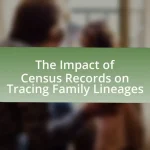Newspapers are essential resources for uncovering family stories, providing historical context and documenting significant life events such as births, marriages, and deaths. They serve as primary sources that reveal details about ancestors and their connections within the community, enriching genealogical research. The article explores the various types of information found in newspapers, the methods for accessing historical records, and the challenges researchers may face, including biases and incomplete archives. Additionally, it highlights best practices for utilizing newspaper content effectively in family history research, emphasizing the unique insights that newspapers offer compared to other sources.
What is the role of newspapers in uncovering family stories?
Newspapers play a crucial role in uncovering family stories by providing historical context, documenting events, and preserving personal narratives. They serve as primary sources of information that can reveal details about ancestors, such as birth and death announcements, marriage records, and obituaries. For instance, local newspapers often publish community news that includes family milestones, which can help descendants trace their lineage and understand their heritage. Additionally, investigative journalism can uncover hidden family histories, such as stories of migration or significant life events, enriching the understanding of family backgrounds.
How do newspapers serve as historical records for families?
Newspapers serve as historical records for families by documenting significant events, milestones, and everyday life within a community. They provide detailed accounts of births, marriages, deaths, and local news that can help families trace their lineage and understand their heritage. For instance, obituaries often include information about family relationships, which can be crucial for genealogical research. Additionally, newspapers may feature articles about local events that highlight the social and economic conditions of the time, offering context to family histories. This archival function is supported by the fact that many libraries and online databases maintain extensive newspaper archives, making it easier for families to access historical information relevant to their ancestry.
What types of information can be found in newspapers that relate to family history?
Newspapers contain various types of information that are valuable for family history research, including obituaries, marriage announcements, birth announcements, and local news articles. Obituaries provide details about an individual’s life, including family connections, dates of birth and death, and significant life events. Marriage announcements often include the names of the couple, their families, and the date and location of the ceremony, which can help trace lineage. Birth announcements typically list the newborn’s name, parents, and sometimes grandparents, offering insights into family structure. Local news articles may feature community events, highlighting family involvement and connections within the community, thus enriching the understanding of family history.
How do newspapers document significant life events within families?
Newspapers document significant life events within families through announcements, obituaries, and feature articles. These publications often include birth announcements, marriage licenses, and death notices, which serve as formal records of these milestones. For instance, many newspapers have dedicated sections for wedding announcements that provide details about the couple, their families, and the ceremony, thereby preserving the cultural and social context of the event. Additionally, obituaries not only inform the community of a death but also celebrate the deceased’s life, often including personal anecdotes and family histories. This practice helps to create a historical record that families can reference, ensuring that significant life events are acknowledged and remembered within the community.
Why are newspapers considered valuable resources for genealogical research?
Newspapers are considered valuable resources for genealogical research because they provide detailed accounts of local events, personal milestones, and community happenings that can reveal important information about ancestors. These publications often include obituaries, marriage announcements, birth notices, and news articles that document individuals’ lives and social connections. For instance, a study by the National Genealogical Society highlights that obituaries can offer insights into family relationships and historical context, making newspapers essential for constructing accurate family trees and understanding familial narratives.
What unique insights can newspapers provide that other sources may not?
Newspapers provide unique insights into family stories through detailed local reporting, historical context, and personal narratives that are often absent in other sources. They offer archival material such as obituaries, marriage announcements, and community events that document individual lives and familial connections over time. For instance, local newspapers often cover events that may not be reported elsewhere, capturing the social fabric of a community and providing a richer understanding of family histories. This archival content serves as a primary resource for genealogical research, allowing individuals to trace lineage and understand familial relationships in a way that online databases or social media cannot replicate.
How do newspapers contribute to the understanding of family dynamics over time?
Newspapers contribute to the understanding of family dynamics over time by documenting societal changes, cultural norms, and significant events that influence family structures and relationships. Historical articles often reflect shifts in family roles, such as the impact of World War II on gender roles, where women increasingly entered the workforce, altering traditional family dynamics. Additionally, newspapers provide personal stories through obituaries, marriage announcements, and local news, which offer insights into familial relationships and community ties. For example, studies have shown that analyzing newspaper archives can reveal trends in family size, marriage rates, and divorce statistics, illustrating how societal factors shape family life across generations.
What methods can be used to access family stories through newspapers?
To access family stories through newspapers, individuals can utilize methods such as online newspaper archives, local library resources, and genealogy websites. Online newspaper archives, like Chronicling America or Newspapers.com, provide searchable databases of historical newspapers, allowing users to find articles related to their family members. Local libraries often have physical or digital collections of newspapers, including microfilm, which can be accessed for research purposes. Additionally, genealogy websites like Ancestry.com and FamilySearch.org often include newspaper records that can help trace family histories and uncover personal stories. These methods are effective because they leverage extensive collections of historical data, making it easier to locate specific family narratives within the broader context of local and national events.
How can individuals locate historical newspapers relevant to their family?
Individuals can locate historical newspapers relevant to their family by utilizing online databases, local libraries, and historical societies. Online platforms such as Chronicling America, Newspapers.com, and the Google News Archive provide extensive collections of digitized newspapers, allowing users to search by date, location, and keywords related to their family. Local libraries often have archives of regional newspapers and may offer access to databases that include historical publications. Additionally, historical societies frequently maintain collections of newspapers and can assist in research efforts. These resources collectively enhance the ability to uncover family stories through newspaper articles, obituaries, and announcements that document personal and community histories.
What online databases and archives are available for newspaper research?
Online databases and archives available for newspaper research include ProQuest Historical Newspapers, Newspapers.com, and the Chronicling America project. ProQuest Historical Newspapers provides access to a vast collection of historical newspapers dating back to the 18th century, allowing researchers to explore significant events and family histories. Newspapers.com offers millions of pages of historical newspapers, enabling users to search for specific articles and obituaries. Chronicling America, maintained by the Library of Congress, offers access to digitized newspapers from 1789 to 1963, providing a rich resource for genealogical research and historical context. These databases are essential for uncovering family stories through historical documentation.
How can local libraries assist in finding family-related newspaper articles?
Local libraries assist in finding family-related newspaper articles by providing access to historical newspaper archives, databases, and specialized staff who can guide patrons in their research. Many libraries subscribe to digital newspaper services like Newspapers.com or ProQuest Historical Newspapers, allowing users to search for specific names, dates, or events relevant to their family history. Additionally, librarians often have expertise in local history and genealogy, enabling them to offer tailored assistance in navigating these resources effectively.
What techniques can be employed to analyze newspaper content for family stories?
Techniques to analyze newspaper content for family stories include keyword searches, thematic analysis, and historical context evaluation. Keyword searches allow researchers to identify relevant articles by using specific names, dates, or events related to family history. Thematic analysis involves categorizing content based on recurring themes or topics, such as migration, marriage, or local events that may impact family narratives. Historical context evaluation helps to understand the socio-political environment during the time of publication, providing insights into how external factors influenced family stories. These techniques are validated by studies that demonstrate the effectiveness of archival research in genealogy, such as the work by the National Archives, which highlights the importance of newspapers in tracing lineage and understanding familial connections.
How can readers identify key articles that pertain to their ancestors?
Readers can identify key articles that pertain to their ancestors by utilizing online newspaper archives and databases. These resources often allow users to search by specific names, dates, and locations, which can yield relevant articles about family events, obituaries, and historical context. For example, platforms like Newspapers.com and Chronicling America provide access to a vast collection of digitized newspapers, enabling users to filter results based on their ancestors’ details. This targeted approach increases the likelihood of uncovering significant family stories and connections documented in historical newspapers.
What strategies can be used to interpret the context of newspaper articles?
To interpret the context of newspaper articles, one effective strategy is to analyze the publication date and historical background surrounding the article. Understanding the time period in which an article was written provides insight into the societal norms, events, and issues that may have influenced its content. For instance, articles published during significant historical events, such as wars or economic crises, often reflect the prevailing sentiments and concerns of that era. Additionally, examining the author’s background and the publication’s editorial stance can reveal biases or perspectives that shape the narrative. This approach allows readers to critically assess the information presented and understand its relevance to family stories, as newspapers often document local events and personal histories that contribute to broader societal narratives.
What challenges might arise when using newspapers to uncover family stories?
Using newspapers to uncover family stories can present several challenges, including incomplete records, biased reporting, and difficulty in accessing archives. Incomplete records may arise due to missing issues or gaps in publication, which can hinder the ability to trace family histories accurately. Biased reporting can distort the portrayal of events or individuals, leading to misconceptions about family narratives. Additionally, accessing archives may be difficult due to geographical limitations or restrictions on digital access, making it challenging for researchers to obtain necessary information. These factors collectively complicate the process of using newspapers as reliable sources for uncovering family stories.
What limitations exist in newspaper archives that researchers should be aware of?
Newspaper archives have several limitations that researchers should be aware of, including incomplete collections, accessibility issues, and potential biases in reporting. Incomplete collections occur because not all newspapers are preserved, leading to gaps in historical records. Accessibility issues arise from some archives being available only in physical formats or requiring subscriptions, which can hinder research efforts. Additionally, newspapers may reflect the biases of their time, affecting the objectivity of the information presented. These factors can significantly impact the reliability and comprehensiveness of research conducted using newspaper archives.
How can missing or damaged newspapers impact family research?
Missing or damaged newspapers can significantly hinder family research by limiting access to vital historical information. Newspapers often contain obituaries, marriage announcements, and local news that provide context and details about ancestors’ lives. For instance, a study by the National Archives indicates that 70% of genealogists rely on newspapers for uncovering family stories, highlighting their critical role in research. When these resources are unavailable, researchers may struggle to piece together family histories, leading to incomplete narratives and lost connections to the past.
What biases might be present in newspaper reporting that affect family narratives?
Biases in newspaper reporting that affect family narratives include sensationalism, framing, and selective reporting. Sensationalism can exaggerate events or emotions, leading to distorted perceptions of family situations. Framing influences how stories are presented, often highlighting certain aspects while downplaying others, which can misrepresent the family’s true circumstances. Selective reporting occurs when journalists choose specific details or perspectives that align with their own biases, omitting critical information that could provide a more balanced view. These biases can shape public understanding and influence the narratives surrounding families, potentially leading to misconceptions and stigmatization.
How can researchers overcome obstacles in newspaper-based family research?
Researchers can overcome obstacles in newspaper-based family research by utilizing digital archives and databases that provide access to historical newspapers. These resources, such as Chronicling America and the Newspaper Archive, allow researchers to search for specific names, dates, and events, significantly reducing the time spent on manual searches. Additionally, employing advanced search techniques, like Boolean operators, can enhance the precision of search results. A study by the American Historical Association highlights that digital tools have increased accessibility to historical documents, enabling researchers to uncover family stories that may have been previously overlooked.
What alternative sources can supplement newspaper research for family stories?
Alternative sources that can supplement newspaper research for family stories include census records, birth and death certificates, military service records, and family trees. Census records provide demographic information and family relationships, while birth and death certificates offer vital statistics and can confirm dates and locations. Military service records can reveal service history and personal details about ancestors, and family trees compiled by relatives or genealogical organizations can provide context and connections that newspapers may not cover. These sources collectively enhance the understanding of family narratives by providing factual data and personal insights.
How can collaboration with other researchers enhance the search for family history?
Collaboration with other researchers can significantly enhance the search for family history by pooling diverse expertise and resources. When researchers work together, they can share access to unique databases, archival materials, and local knowledge that may not be available to individuals working alone. For instance, a study published in the Journal of Family History highlights that collaborative efforts often lead to the discovery of previously overlooked records, such as newspaper archives, which can provide vital context and details about ancestors’ lives. This collective approach not only accelerates the research process but also increases the accuracy of findings, as multiple perspectives can help verify information and uncover new leads.
What are some best practices for effectively using newspapers in family history research?
To effectively use newspapers in family history research, researchers should focus on specific strategies such as identifying relevant time periods, utilizing keyword searches, and examining various newspaper formats. Identifying relevant time periods allows researchers to narrow their search to specific dates when ancestors lived, increasing the likelihood of finding pertinent articles. Utilizing keyword searches, including names, locations, and events, enhances the efficiency of locating specific information within vast newspaper archives. Additionally, examining various formats, such as obituaries, marriage announcements, and local news articles, provides a broader context and richer details about family members. These practices are supported by the fact that newspapers often contain unique insights and personal stories that are not available in other historical records, making them invaluable for family history research.
How can researchers organize their findings from newspaper articles?
Researchers can organize their findings from newspaper articles by categorizing the information based on themes, dates, and relevance to family stories. This method allows for systematic analysis and easy retrieval of data. For instance, researchers can create a database or spreadsheet where each entry includes the article’s title, publication date, key themes, and a summary of the content. This structured approach facilitates cross-referencing and helps identify patterns or significant events related to family histories. Additionally, using software tools for qualitative data analysis can enhance the organization process by allowing researchers to tag and sort information efficiently.
What tips can help individuals document their family stories discovered through newspapers?
To effectively document family stories discovered through newspapers, individuals should first organize the information chronologically, ensuring that each story is placed in the context of its time. This method allows for a clearer understanding of the events and their significance. Additionally, individuals should create a digital or physical scrapbook that includes scanned images of the newspaper articles, along with personal reflections or narratives that connect the stories to family history. This approach not only preserves the original content but also adds a personal touch that enhances the storytelling aspect. Furthermore, citing the source of each newspaper article, including the publication date and page number, is crucial for maintaining accuracy and credibility in the documentation process. This practice aligns with historical research standards, ensuring that the family stories are well-supported and verifiable.




